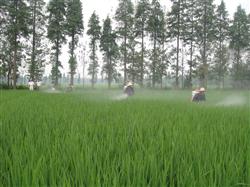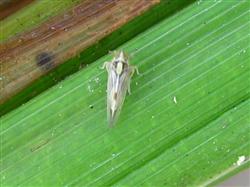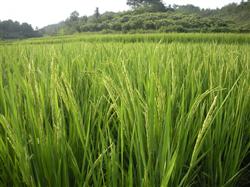How to administer medicine before and after heading of rice?

How to administer medicine before and after heading of rice? Please give guidance and introduction to whether it is early rice or late rice, before and after heading is generally the occurrence of a variety of diseases and insect pests, the need for chemical pesticide control, but in this growth period, some are very easy to cause drug damage, resulting in unnecessary losses, worthy of attention. Before heading, rice with triadimefon is often harmed by rice blast and bacterial blight. Triadimefon (triadimefon) is commonly used to control rice, but if it is not used properly, rice leaves will be short and can not heading seriously. The mechanism of triadimefon fungicides to control diseases is to inhibit the activity of monooxygenase in fungi, destroy ergosterol biosynthesis and lead to cell membrane damage and death. It can also inhibit gibberellin biosynthesis in plants, so that gibberellins that promote cell growth can not be synthesized, so that plants are dwarfed, leaves and fruits are short. In the early heading stage of late rice, pesticides such as 12% diniconazole wettable powder are commonly used to control rice false smut, and the pesticide is excessive, which is easy to cause difficulty in heading of late rice, or stop when the panicle is half out. After the application of uniconazole pesticides such as Quxingxing and Heguoli in the breaking stage or early heading stage of rice, different degrees of drug reactions appeared in a large area of rice, and the growth of panicle neck internodes was affected, and the phenomenon of "neck wrapping" appeared and could not heading normally. After the occurrence of drug damage, spraying gibberellin as early as possible can relieve the damage to a certain extent, generally spraying with 2 grams of 920 per mu and 50 kg of water. The improper use of arsenic preparation on rice will cause drug damage to rice, which will not bear fruit or decrease the seed setting rate. At present, tricyclazole, prochloraz and prochloraz are generally selected in production to control rice blast, and it is best to use these agents alternately when they are used many times. Imidazoles fungicides are used cautiously before and after heading of rice. If they are well used, disease prevention will increase; if not, heading filling will be affected. The compound agents of hexazolol and Jinggangmycin, such as Wen Su, propiconazole, diniconazole and thiofuramide, such as Dianlide, Heguoli, full ear, etc., these drugs can generally last more than 15 days, and are effective in controlling rice sheath blight. It should be noted that tebuconazole, diniconazole, hexaconazole, propiconazole and other azole fungicides can inhibit the formation of gibberellin in rice, and the long-term use of the upper Internode of rice, especially when the dosage is added, may inhibit the elongation of internodes and lead to heading difficulties. affect rice grain filling and fruiting. Mistakenly spraying glyphosate at booting stage does great harm to glyphosate rice. If glyphosate is mistakenly applied to hybrid rice fields, a large area of rice can be damaged, the rice fields cannot heading normally, and the yield will be lost by 80% to 100%. Glyphosate is an internal absorption and transmission type of inactive herbicide. The differentiation site of young spike is easy to produce drug damage, resulting in symptoms such as heart leaf death, young panicle deformity and so on. Spraying appropriate amount of gibberellin and potassium dihydrogen phosphate in time after accidental glyphosate damage in rice field can promote the growth and development of young panicle to a certain extent, and appropriate amount of urea can be sprayed 7 days later. Generally, the remedial effect is better at the peak tillering stage and the early stage of young panicle differentiation, but at the booting stage, especially in the late booting stage, the base of the rachis becomes brown and necrotic, and the remedial effect is poor. Click to get more rice planting techniques click to get more food crop planting techniques
- Prev

How to control rice planthopper?
How to control rice planthopper? Please introduce the control methods of rice planthopper can refer to the following methods: first, reasonable close planting, improve field microclimate, improve rice disease resistance. Second, rational fertilization, control of nitrogen fertilizer, increase the application of phosphorus and potassium fertilizer, skillful application of topdressing, so that early growth and rapid development of rice.
- Next

How to manage the heading and fruiting stage of rice?
How to manage the heading and fruiting stage of rice? Please introduce the management method of rice heading and fruiting stage, which refers to the period from heading to yellow maturity, which is the key period for determining grain number and grain weight. The goal of field management is to raise root, protect leaves, increase seed setting rate and 1000-grain weight. The main measures of field management.
Related
- The first cup of black tea in spring, the flavor and history of tea gardens in Kenya, Africa
- The computer can not only choose potatoes, but also grow tea rice. AI will grow winter oolong tea champion.
- It is not only the inflated tea bitten by insects, but also engraved with the four seasons tea in Beipu.
- The Oriental Beauty Tea Festival in Zhuxian County takes the stage at the weekend to experience the plus-size feast of oil tea.
- & quot; Oriental Beauty Tea & Exploration of Emei in Hsinchu, the hometown of quot;
- The new variety of strawberry "Tainong 1" dessert is the first choice with mellow aroma. Crimson gorgeous
- History of Tea in Taiwan: from Wild Inner Mountain to Export Tea Garden
- Two types of Taiwan Oriental Beauty Black Tea won the British three-Star Award for Childhood Tea Xiang Zhang Jiaqi changed from pilot to champion tea maker.
- Banana species and varieties: the planting history of Taiwan Xianren banana and dwarf banana is long, is banana disease resistant?
- Coffee planting Technology: Qianjie Coffee from Seedling to harvesting

